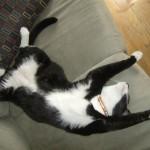Posted by Anne M on Tuesday, Nov 5, 2013
Last month, I heard John Bradshaw on Fresh Air with Terry Gross explaining that cats do not necessarily sit on us for our warmth, they sit on us because we are friends. I liked the thought of this. I always believed that Gatsby (my cat) and I are in good standing, but can you ever really say you are friends with your cat? Well, I do, but I fully acknowledge that it is a complicated relationship. There are times I wouldn't argue with someone that says cats are only in it for the food.
Cat Sense, John Bradshaw's latest pet science book, doesn't just reinforce good feelings about having my cat around. He discusses the latest studies on cat behavior to explain some of their habits, provides advice on how to interpret whether cats are comfortable with their environment, and explains how to manage their undesirable innate behavior, such as the need to hunt or the inability to get along with other cats. Bradshaw is concerned that cats need to adapt to modern expectations. We want friendly cats who, for the most part, live indoors, leave songbirds alone, and coexist with other cats or with dogs in the home. And we are asking for this rather quickly. Bradshaw puts this in perspective by providing an interesting history of how the cat has evolved as one of our companions.
 I'm pretty sure that Gatsby bears me no ill will seeing as how he seems to feel extremely safe when he sleeps as illustrated in the accompanying photograph.
I'm pretty sure that Gatsby bears me no ill will seeing as how he seems to feel extremely safe when he sleeps as illustrated in the accompanying photograph.
If you are not a cat person, Bradshaw's previous book covered the same issues with dogs.


Lyndsay Faye writes some really good, suspenseful historical fiction and The Paragon Hotel is no exception. Set during Prohibition, Faye really captures the city of Portland in the early 1920's, the unease of the post-war years, and vividly brings a variety of characters to life. -Anne M